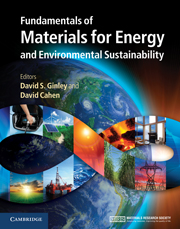Book contents
- Frontmatter
- Contents
- Contributors
- Preface
- Acknowledgments
- Part 1 Energy and the environment: the global landscape
- Part 2 Nonrenewable energy sources
- Part 3 Renewable energy sources
- Part 4 Transportation
- Part 5 Energy efficiency
- 35 Lighting
- 36 Energy efficient buildings
- 37 Insulation science
- 38 Industrial energy efficiency: a case study
- 39 Green processing: catalysis
- 40 Materials availability and recycling
- 41 Life-cycle assessment
- Part 6 Energy storage, high-penetration renewables, and grid stabilization
- Summary
- Appendix A Thermodynamics
- Appendix B Electrochemistry
- Appendix C Units
- Index
- References
37 - Insulation science
from Part 5 - Energy efficiency
Published online by Cambridge University Press: 05 June 2012
- Frontmatter
- Contents
- Contributors
- Preface
- Acknowledgments
- Part 1 Energy and the environment: the global landscape
- Part 2 Nonrenewable energy sources
- Part 3 Renewable energy sources
- Part 4 Transportation
- Part 5 Energy efficiency
- 35 Lighting
- 36 Energy efficient buildings
- 37 Insulation science
- 38 Industrial energy efficiency: a case study
- 39 Green processing: catalysis
- 40 Materials availability and recycling
- 41 Life-cycle assessment
- Part 6 Energy storage, high-penetration renewables, and grid stabilization
- Summary
- Appendix A Thermodynamics
- Appendix B Electrochemistry
- Appendix C Units
- Index
- References
Summary
Focus
Energy efficiency has been recognized as the most effective near-term means to meet the energy and environmental crisis we face today. In the USA, buildings are the largest energy-consumption sector of the economy. Residential and commercial buildings combined consume over 40% of the primary energy and over two-thirds of the total electricity [1]. Heating and cooling are the largest portions of this. Demonstration homes have shown that the heating consumption can be reduced by as much as 90% by the proper application of very thick thermal insulation in the walls, roof, and windows [2]. One challenge is the development of very thin economical insulation materials that provide the same performance.
Synopsis
Thermal insulations comprise a wide variety of materials whose primary function is the reduction of heat and mass transfer. These insulations are made from foams, fibers, and other fine-structured solids that encapsulate a gas or are held in vacuum. In buildings, insulation improves energy efficiency by reducing heat loss in winter and heat gain in summer. Even modern windows have been designed to act as insulators to improve building performance. Appliances such as refrigerators and ovens use insulation to maintain temperature and to be more energy-efficient. Insulations are also used in industrial operations such as furnaces for metal and glass manufacture as well as as a means to control silicon-chip formation. In space and on Earth, insulations are used for protection in harsh environments. The development of the next generation of insulations requires an understanding of the physics of heat transfer and of the role advanced materials play in limiting heat transfer by the mechanisms of conduction, radiation, and convection.
- Type
- Chapter
- Information
- Publisher: Cambridge University PressPrint publication year: 2011



